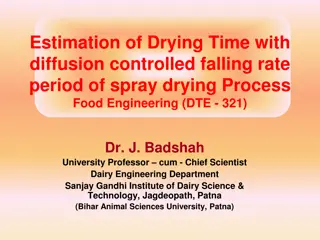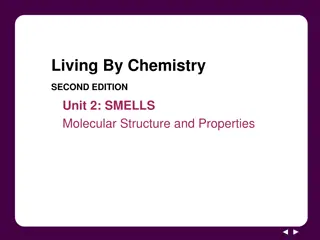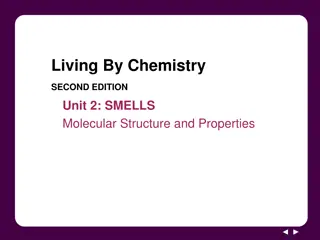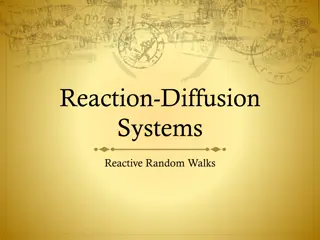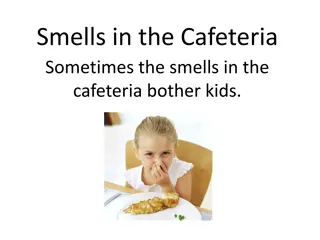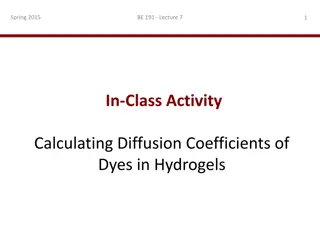Understanding the Science of Smells through Odor Diffusion
This report delves into the intriguing world of smells, focusing on how odors spread through the air and are detected by the human nose. It covers the definition of smell, the role of volatile molecules in odors, the process of orthonasal olfaction, and the mechanisms behind odor diffusion. The study explores the phenomenon of odor perception and the fascinating journey of molecules from high to low concentration regions. Dive into the complexities of our sense of smell through this comprehensive investigation.
Download Presentation

Please find below an Image/Link to download the presentation.
The content on the website is provided AS IS for your information and personal use only. It may not be sold, licensed, or shared on other websites without obtaining consent from the author. Download presentation by click this link. If you encounter any issues during the download, it is possible that the publisher has removed the file from their server.
E N D
Presentation Transcript
8.Smells Greece - Anatolia College Reporter: Olga Mavrimati Hellenic Physical Society Minsk - IYNT 2019 1
Phenomenon to be Investigated Smells spread through the air, however it would take some time before a human nose is able to detect the smell. Study different aspects of odor diffusion and sensation of odor by humans. 2
Theoretical Introduction Definition of smell: Smell is the procedure in which somebody perceives the odor or scent through stimuli affecting the olfactory nerves and system. Humans have the ability to distinguish over 10,000 different smells and odors Heated food is easier to smell by a distance than cold food Solid objects are highly unlikely to have a smell or odor 3
Odor Odor definition: Odor is a quality of a liquid or gas ,that stimulates the olfactory organ and receptors in the nasal cavity. The odor of something consists of: Volatile molecules Easy to evaporate chemicals Esters, when referring to the smell of a flower or fruit 4
Odor Orthonasal Olfaction (The process of smelling through the nose) Molecules, which are easy to evaporate, travel through the air molecules and reach one s nose The molecules pass up the nose and reach the olfactory epithelium There they reach mucus and cilia The molecules meet the odour receptors 5
Odor The molecules bind with the receptor cells to create a signal These signals are passed along nerve- fibers They converge on a structure on the frontal lobe Finally the signals are processed and we are enabled to smell and distinguish odors 6
Odor diffusion Diffusion is the movement of molecules from a region of high concentration to one of low concentration . e.g. : If you have ever opened a bottle of cologne or , you have witnessed diffusion. Molecules of the scent escape from the container, where they are present in very high concentration. They spread outward in every direction to regions where they are in low concentration. Your nose is able to detect the smell of the cologne or perfume even if you are quite a distance from the bottle that has been opened. 7
Odor diffusion Brownian motion or movement: Physical phenomena, in which some quantity is constantly and continuously undergoing some kind of random but small changes and fluctuations. According to the Brownian movement: If a number of particles,which are subjected to Brownian motion , exist in a given medium and there is no direction for the random oscillations,then the particles tend to be spread out evenly throughout the medium 8
Odor diffusion Characteristics of diffusion: The particles of odors,when diffused, are mixed with the particles of air The particles of the odor move in an un-orderly manner until they are completely spread across a space The particles still move even when the smell is evenly spread Odor diffusion is a microscopic manifestation of the Brownian motion 10
The speed of smell The fundamental determinant of its speed is its tendency to spread out across a medium. Other factors which can affect the speed of smell are : Temperature Air pressure External movement (eg. wind) The speed of each smell depends on many factors and therefore is not easy to be specified and determined on a general level 11
The speed of smell Graham s Law of Effusion: The rate of effusion of a gaseous substance is inversely proportional to the square root of its molar mass. [Effusion, is the escape of gaseous molecules through a small (usually microscopic) hole, such as a hole in a balloon, into an evacuated space.] The rate and speed of the diffusion of gas molecules at higher temperatures are greater , since the molecules have greater kinetic energy 12
Primary Odors Classification 1. Spicy 2. Flowery 3. Burned 4. Fruity 5. Patrid 6. resinous 14
Analytic experiment We made 3 experiments using the following materials: Spicy: cinamon Burned: burned paper Fruity:lemon Patrid : rotten egg Flowery: rose Resinous: pine 15
1st experiment Aim: in what distance do we start to smell the odor? Conditions: Room with closed doors and windows Stable temperature 25 C No external factors (air pressure modification, wind, other odors) 16
1st experiment - procedure 1. Person A: a. opens plastic bowl with 4 grams of cinnamon grains at 2 meters away from Person B b. starts walking towards from Person B, with stable slow speed. c. stops walking when Person B smells the cinnamon, d. measures the distance AB: 0,85 meters 2. Leave windows open and set air condition in 25 celsius 17
1st experiment - Results Sample Smelling Distance Rotten egg 1,42 meters Cinnamon 0,83 meters Pine branch 0,78 meters rose 0,61 meters Orange 0,56 meters Burnt paper 0,50 meters 18
Comparing the results of the experiment with the theory Ranking (experiment) Sample Ranking (theory) Sample 1. Rotten egg 1. Rotten egg 2. Cinnamon 2. Cinnamon 3. Pine branch 3. Pine branch 4. rose 4. rose 5. lemon 5. Burnt paper 6. Burnt paper 6. lemon 19
Sources List of sources: https://health.howstuffworks.com/mental-health/human- nature/perception/question139.htm https://www.bbc.com/bitesize/guides/zc9q7ty/revision/8 http://www.scienceclarified.com/Di-El/Diffusion.html http://www.fifthsense.org.uk/how-smell-works-2/ https://io9.gizmodo.com/5831558/what-is-the-speed-of-smell https://chem.libretexts.org/Textbook_Maps/Physical_and_Theoretical_Che mistry_Textbook_Maps/Map%3A_Physical_Chemistry_for_the_Biosciences _(Chang)/02%3A_Properties_of_Gases/2.9%3A_Graham's_Laws_of_Diffus ion_and_Effusion https://www.britannica.com/science/Brownian-motion 20
THANK YOU FOR YOUR TIME! 21













